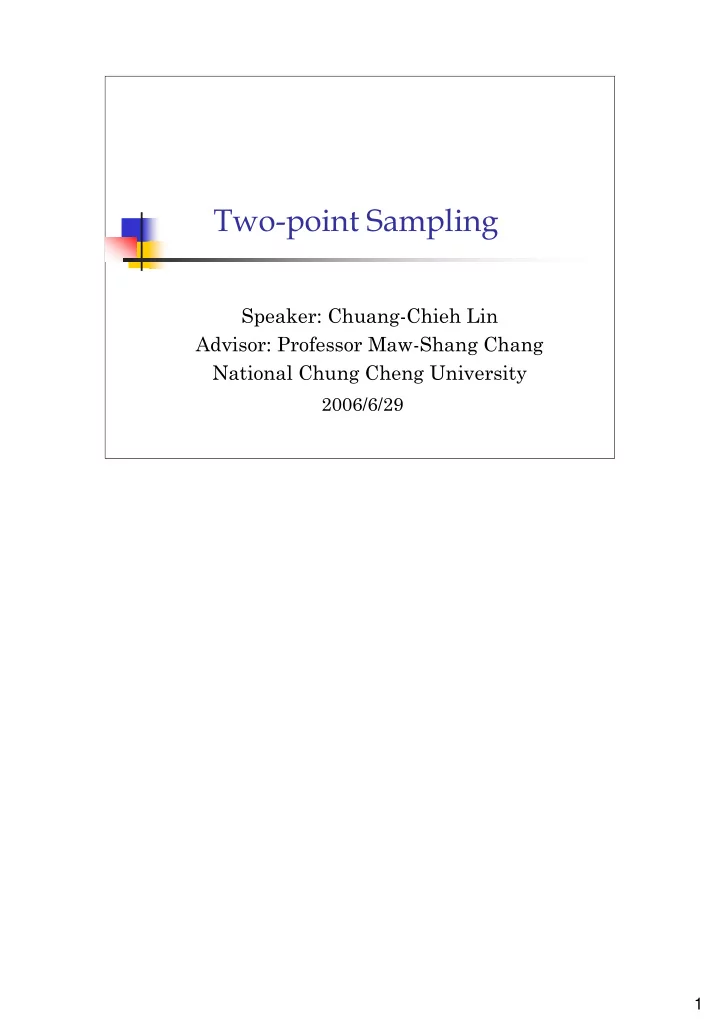

Two-point Sampling Speaker: Chuang-Chieh Lin Advisor: Professor Maw-Shang Chang National Chung Cheng University 2006/6/29 1
References � Professor S. C. Tsai’s lecture slides. � Randomized Algorithms , Rajeev Motwani and Prabhakar Raghavan. 2006/6/29 2006/6/29 2 2 Computation Theory Lab, CSIE, CCU, Taiwan Computation Theory Lab, CSIE, CCU, Taiwan 2
Joint probability density function � X , Y : discrete random variables defined over the same probability sample space. � p ( x , y ) = Pr [{ X = x } ∩ { Y = y }]: the joint probability density function (pdf) of X and Y . Pr [ Y = y ] = P � Thus, p ( x, y ) x p ( x,y ) and Pr [ X = x | Y = y ] = Pr [ Y = y ]. 2006/6/29 2006/6/29 3 3 Computation Theory Lab, CSIE, CCU, Taiwan Computation Theory Lab, CSIE, CCU, Taiwan 3
� A sequence of random variables is called pairwise independent if for all i ≠ j , and x , y ∈ R R, Pr [ X i = x | X j = y ] = Pr [ X i = x ]. 2006/6/29 2006/6/29 4 4 Computation Theory Lab, CSIE, CCU, Taiwan Computation Theory Lab, CSIE, CCU, Taiwan 4
Randomized Polynomial time ( RP ) � The class RP (for Randomized Polynomial time) consists of all languages L that have a randomized algorithm A running in worse-case polynomial time such that for any input x in ∑ * ( ∑ is the alphabet set), F x ∈ L ⇒ Pr [ A ( x ) accepts] ≥ 1 2 . F x / ∈ L ⇒ Pr [ A ( x ) accepts] = 0. 2006/6/29 2006/6/29 5 5 Computation Theory Lab, CSIE, CCU, Taiwan Computation Theory Lab, CSIE, CCU, Taiwan 5
Try to reduce the random bits… � We now consider trying to reduce the number of random bits used by RP algorithms. � Let L be a language and A be a randomized algorithm for deciding whether an input string x belongs to L or not. 2006/6/29 2006/6/29 6 6 Computation Theory Lab, CSIE, CCU, Taiwan Computation Theory Lab, CSIE, CCU, Taiwan 6
� Given x , A picks a random number r from the Z n = {0,1,…, n − 1}, with the following range Z property: � If x ∈ L , then A ( x , r ) = 1 for at least half the possible values of r . � If x ∉ L , then A ( x , r ) = 0 for all possible choices of r . 2006/6/29 2006/6/29 7 7 Computation Theory Lab, CSIE, CCU, Taiwan Computation Theory Lab, CSIE, CCU, Taiwan 7
� Observe that for any x ∈ L , a random choice of r is a witness with probability at least ½. � Goal: We want to increase this probability, i.e., decrease the error probability. 2006/6/29 2006/6/29 8 8 Computation Theory Lab, CSIE, CCU, Taiwan Computation Theory Lab, CSIE, CCU, Taiwan 8
A strategy for error-reduction There is a strategy as follows: � Pick t > 1 values, r 1 , r 2 ,.. r t ∈ Z Z n . � Compute A ( x , r i ) for i = 1, …, t . � If for any i , A ( x , r i ) = 1, then declare x ∈ L . � The error probability of this strategy is at most 2 − t . � Yet it still uses Ω ( t log n ) random bits. � Why? 2006/6/29 2006/6/29 9 9 Computation Theory Lab, CSIE, CCU, Taiwan Computation Theory Lab, CSIE, CCU, Taiwan 9
Strategy of two point sampling Actually, we can use fewer random bits. � Choose a , b randomly from Z Z n . � Let r i = a ⋅ i + b mod n , i =1,…, t , then compute A ( x , r i ). � If for any i , A ( x , r i ) = 1, then declare x ∈ L . � Now what is the error probability? 2006/6/29 2006/6/29 10 10 Computation Theory Lab, CSIE, CCU, Taiwan Computation Theory Lab, CSIE, CCU, Taiwan 10
� r i = ai + b mod n , i =1,…, t . � r i ’s are pairwise independent. � (See [MR95], Exercise 3.7 in page 52) t = ∑ � Let ( , ) Y A x r i = i 1 t t ∈ ⇒ ≥ σ ≤ ← 2 [ ] ? x L E Y and why Y 2 4 2006/6/29 2006/6/29 11 11 Computation Theory Lab, CSIE, CCU, Taiwan Computation Theory Lab, CSIE, CCU, Taiwan Suppose E [ A ( x , r i )] = \mu \geq ½, we have Var [ A ( x , r i )] = \mu * (1-mu). By simple calculus analysis, we have Var [ A ( x , r i )] \leq ¼, thus Var [ Y ] = \sum_{ i =1}^{ t } Var [ A ( x , r i )] \leq t/4. 11
� What is the probability of the event { Y = 0}? Y = 0 ⇒ | Y − E [ Y ]| ≥ t /2. = ≤ − ≥ t Thus [ 0 ] [| [ ] | ] Pr Y Pr Y E Y 2 ≤ − ≥ σ [| [ ] | ] Pr Y E Y t Y ≤ 1 . t Chebyshev’s Inequality: Pr [|X − μ x | ≥ t σ X ] ≤ 1/ t 2 2006/6/29 2006/6/29 12 12 Computation Theory Lab, CSIE, CCU, Taiwan Computation Theory Lab, CSIE, CCU, Taiwan 12
Thank you. 13
Recommend
More recommend